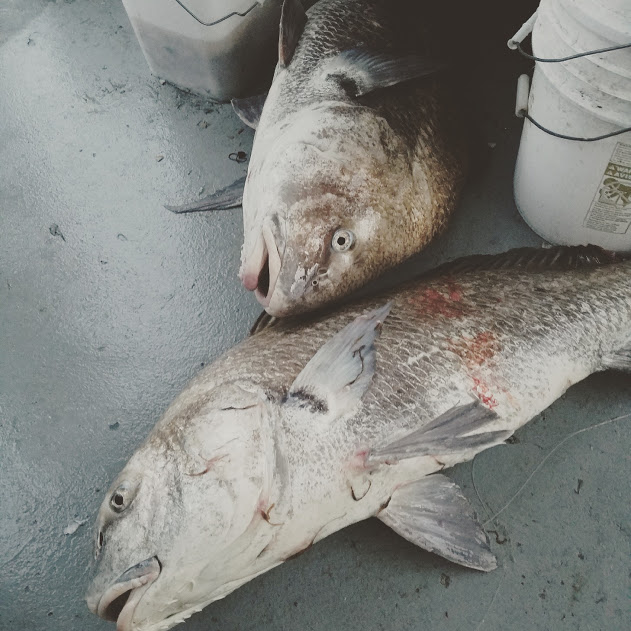5.13.2017

The Black Drum Fish are here. The Fluke fight is coming to an end. Memorial Day is around the corner.
We are fishing for Black Drum, or Pogonias cromis, and we have been doing well, when we make it out.
The Fluke ruling is a mish-mosh of mis led politics, un-proven science, flute music, and white noise, of which all my comments will fall into the later, so, I will spare you that bologna for a future report…
The spring time in Cape May brings about all sorts of interesting change. The sleepy towns of Cape May and Wildwood and Sea Isle start to spring back to life. People come down to open up their “Shore House.” Other folks flock to the shore with severe cabin fever, eager to see the waves crashing on the beach, the gulls mating, and feel the sand between their toes. Businesses slowly but surely open up, then open their schedules some more and then get around to their summer schedules.
At the same time, the waters around the Cape of New Jersey come to life as well. The bait swells in Delaware Bay, and the back-water estuaries feeding it. Mullet, sardines, shiners, minnows, spot, and a plethora of others can be found in abundance. The Menhaden fill the Delaware Bay from Salem down to the Villas and then start to flood out into the Atlantic. All manner of fisherman, woman and beast comes to feast on this vast buffet that is the Delaware Bay in Spring time.
The Predators that flock to the bay for this bait come in all shapes and sizes. Striped Bass, finish spawning up the river and then gorge themselves on the bunker fish. Large whales, like Humpbacks, or Megaptera novaeangliae, swarm the bay and the surrounding areas of Cape Henlopen and Cape May feeding on 2-3000 pounds of it, daily.
Another favorite of the Delaware Bay and a staple of fishing in this area are the massive Black Drum. Ranging in size from Puppy drum at 15-20 pounds, up to 100 pounds, these big, ugly prehistoric monsters funnel into the shallow parts of the Bay in both Delaware and Cape May, and take up residence for a month, and sometimes longer.
These fish are a favorite with locals and tourists alike. Anchoring up in the sloughs and shoals of the bay is the ticket, and whole clams is the bait. While waiting at anchor, other species will come along to nibble at the baits ranging from clear nosed skates to smooth dog fish and horseshoe crabs. The occasional Striped Bass can be caught on these trips, though Bunker is the bait of choice for a Striper.
The bite is a slow pick or nibble and can easily be mistaken for a tiny ling cod or crab. You do not want to set the hook right away, but rather let them inhale the clam and then slam it home. The fight of the Drum is considered by many to be lack luster. They use their weight and size to their advantage, particularly in the unrelenting tide and current of Delaware Bay. This strong tide will be the biggest factor in the fight and test the strength of the best knots, monofilament and rods. Be prepared for a healthy fight, depending on your gear.
We rig our rental rods with heavier line for drum, to withstand the abuse of the tide. We try to leave as little room for error on our Penn Long Beach 60 and 65 reels with fresh line, and rods without defect in guides and reel seats. Larger hooks are preferred in the 5/0 chunking style. Bigger can be better and recommended. A bait holder barb on the hook can make the clam last a little longer in the vicious bay current. 4/0 Reels are not uncommon, but in this day and age of light tackle, inevitably someone will be trying to catch one on spinning tackle though, this practice leads to longer fights, exhausted fish and fisherman, and lost fish.
Once anchored, the magic of Delaware Bay surrounds you. If it is calm enough and the drum are plentiful enough, you will hear their deep bass, characteristic, “drumming.” It is said that this natural beat of the Black Drum is their mating call, which goes hand in hand with all the life of Delaware Bay in Spring.
As table fare, these beasts are best fileted out nice and neat. The Drum family does not have a huge amount of filet, though other parts depending on size are equally tasty, like their ribs, which are large and abundant. This Captain’s favorite method for cooking is the BBQ grill. I have also fried and baked this wonderful fish with good to great results.
So, if you are up for it, think about heading to Cape May in May and even June to locate these local leviathans. The weather is the factor. Spring Westerlies mess up the bay and make fishing poor. Though, Nor’ Easters can be fished when the fish are on the New Jersey side of the bay, in the lee of the peninsula. Be prepared for all types of weather, both cold and hot, windy and calm, dry and wet. Also consider small crowds and other days when it’s just you showing up as getting started is a struggle some springs for business. Either way once you get fishing and hook your first Drum, you will know, they are worth the hunt.
